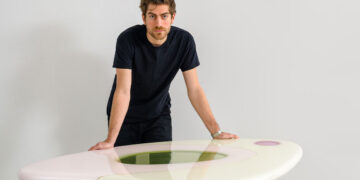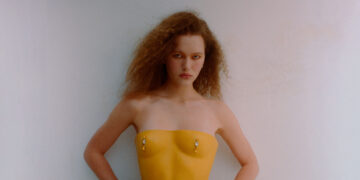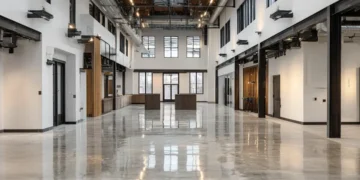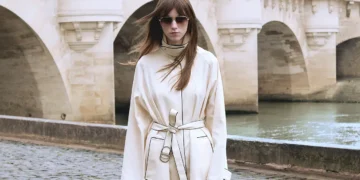
The French designer Djivan Schapira can often be found in his New Jersey atelier, handcrafting pieces of glossy furniture for clients like Louis Vuitton, Waldorf Astoria, and Bergdorf Goodman. With a creative practice rooted in artisanry, it blends retro and futuristic design aesthetics with nuanced techniques, inspired by a modern myriad of inspirational touchpoints—from Sci-Fi film production and Bauhaus architecture to costume design and his own family.
As the saying goes, the apple doesn’t fall far from the tree. Schapira’s father, Antoine, is also a craftsman, and this is when Djivan’s informal training began. After learning from his dad through early adulthood, Schapira then ventured to New York to study architecture at Parsons School of Design until 2016. After building technical skills and an understanding of material, scale, space, and engineering, he began experimenting with resin and launched a made-to-order furniture and interiors atelier. Residential and commercial spaces followed as clients, including The Hoxton, Downtown LA, The Venetian Las Vegas, and the Waldorf Astoria Lusali, Doha.
LIMITED COPIES LEFT – ORDER IN PRINT and DIGITAL
Since, through his expert technique and an emotional-guided eye, he’s created a collection of unique resin works that seamlessly blend playfulness and practicality. First, that was seen in a collection named “Les Fleurs,” filled with trays, wall hangings, and decorative items. Originally set to debut in March 2020, its release was delayed due to the global Coronavirus pandemic. In the time that followed, Schapira pivoted to honing his skills and personal style, evolving “Les Fleurs” and his practice at large into an ultra-personal project of functional artwork. Schapira shared in an exclusive conversation with DSCENE Magazine contributing editor ELIZA JORDAN how his creative practice has evolved over the years, and what items he hasn’t designed but aims to next.

Your creative journey began at home, training under your father. How did his practice ultimately shape yours? – My father, Antoine Schapira, has a comprehensive background in the French decorative arts and studied at the renowned École Boulle School in Paris in the late 1970s. It was there that he learned his trade and particularly an extensive attention to detail in developing furniture which he later passed on to me. If I had to pick one or two main things that shaped the designer I am today, it would have to be understanding the diligence it takes to produce good quality works while always being open to exploring new techniques and materials in search of satisfying our creative abilities.
What did you learn from him that you couldn’t learn at school? – While studying architecture at Parsons School of Design I primarily learned about scale and how to interact with the human condition. This encapsulated everything from material and structural understanding as well as how light can enhance spaces through subtle lighting conditions and play. While everyone knows how work-intensive architecture school can be, it was definitely through working with my father that I developed the grit it takes to work as an artist in this day and age. Being aware of the constant rollercoaster ride that it is, is something that can only be taught through experience and that is undoubtedly something he was able to pass on to me.
“I constantly am looking for ways to showcase design in a sleek and pleasing way”
How did your aesthetic come to be? What drew you to this look? – My aesthetic developed over time, however, you could say it’s always been grounded in soft lines and vibrant colors. These conditions I would say are primarily inspired by 1950s and ‘60s automotive design, back when design had a very futuristic outlook.
After studying architecture at Parson’s, you began your atelier, working on made-to-order projects, and aimed to create a cohesive collection, “Les Fleurs,” but COVID-19 halted production. What did that time amid isolation provide you instead—and ultimately the collection when it officially launched years later? – In a way, the break that COVID forced on all of us was exactly what I needed when considering my creativity and how I wanted to pursue my next chapter. It allowed me the time to focus on creating larger works which for me was a great segue way into the collectible design sector that I am in today. It was during that time that I switched my focus from trying to make volume-based products and instead decided to focus on more significant bodies of work, Les Fleurs being the first of many.

What about working with resin has been attractive to you? Why this material? – Resin has always attracted me due to the countless ways in which it can be used. While it’s been my main medium for the last 6 years, I still feel like I’ve only scratched the surface of what I can do with it.
Tell us a bit about your studio, and what a typical day working there is like. – My studio over the years has truly become my creative haven. It’s doused in vibrant artworks all over the walls as well as houses dozens of plants which in my opinion take away from the common “factory” feel and make it feel more alive. I’m also blessed to have large bay windows that look out onto the Manhattan skyline, which has always be a source of inspiration for me. As far as a typical work day, it depends. Sometimes it can consist of me sitting at my desk with a coffee designing on the computer, trying to figure out how to physically build something or sometimes it consists of me being on my feet for 8-10 hours a day running around between the wood and resin shops. I find to be the happiest when a week consists of 1-2 days of designing and 4-5 days of shop labor. I truly love working with my hands so being busy in the shop truly is my happy place.

You’re represented by Todd Merrill Studio, and have created design pieces for an array of companies and clients. How do you typically work collaboratively on a project with a brand? What is this process usually like? – Typically, designers will reach out already knowing my style so they usually have something in mind that they need where which I can add my own bit of flavor to complement their space and vision. When working with brands such as Louis Vuitton, it’s about developing a piece that will be strictly complimentary so as to not take too much focus away from the products that they are featuring on top of my works. This I find to be a very interesting dialogue in comparison to when I have complete creative control, which satisfies another part of my creative process.
Your designs are functional artworks. How would you describe a quintessential “Djivan Schapira” piece to someone new to your work? – “Retro-futurism” would be the easiest way to describe my work. I constantly am looking for ways to showcase design in a sleek and pleasing way. I tend to do this through the use on soft and comfortable lines paired with sometimes bold or subtle color combinations.
Some of your recent works marry the visuals of retro-futurism and the high-end French decorative arts techniques (like marquetry and lacquer), which you learned from your father. What about this juxtaposition is of interest to you? – I think the juxtaposition primarily lies in quality. Attention to detail is something that both these styles require and I’m always looking for new ways to portray that.

What other influences do your pieces embody (travel, music, film, literation—or “the production art of Tron, Daft Punk’s visionary costumes, the Bauhaus revival of the 1970s,” etc.)? – It’s tough pin-pointing exactly where I find inspiration, but artists such as [Andy] Warhol, Gio Ponti, and MC Escher have definitely inspired design notions.
Right now, you’re working on a new piece for Louis Vuitton’s store in Dubai. Can you tell us about this work? – This piece further exemplifies works I’ve done for them in the past which focus on embedding natural materials in resin (primarily pinecones) which when sliced have a very floral aesthetic. This also happens to be the main pillar of my debut collection “Les Fleurs” which is a pleasure because I still get to produce pieces in the style that really kicked off my career. The other large piece I’m currently working on is a dining table for a private client. This piece, on the other hand, exemplifies the new style that I’ve been developing that stems from my “Orbit Occasional” series, which highlights slightly tinted resin rings that allow light to cast through them, which gives the pieces a very futuristic and spatial look.
Is there an item you haven’t designed yet but want to? – While I’ve mainly worked on tables thus far, I’m looking forward to producing other large home furnishings, such as more cabinetry, and at some point a large room divider. Lighting and seating will likely come after that.





















absolutely love his work finally times for some refreshing furniture design
i love djivan’s side tables!
Djivan is so talented ! Love his work!
wow those side tables by djivan! dreamy ❤️❤️❤️
Beautiful work Djivan is so talented ❤️